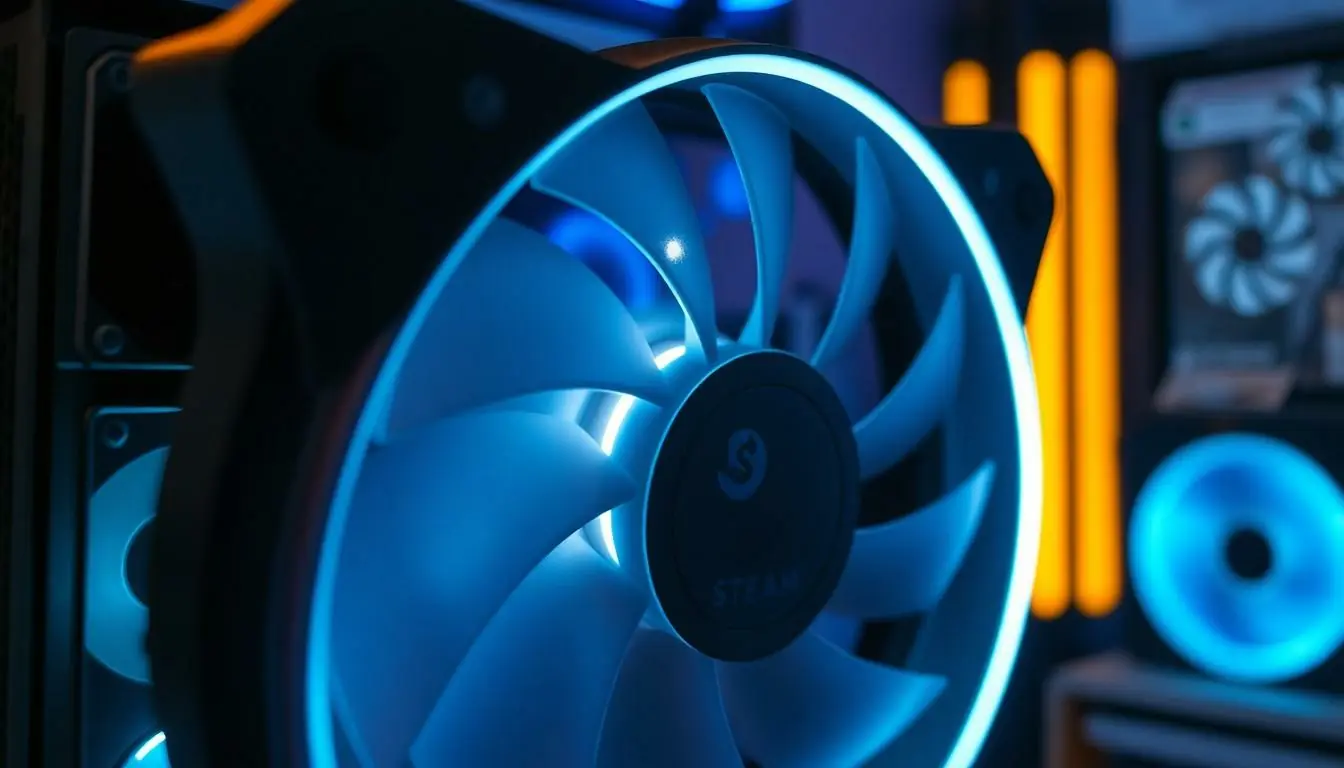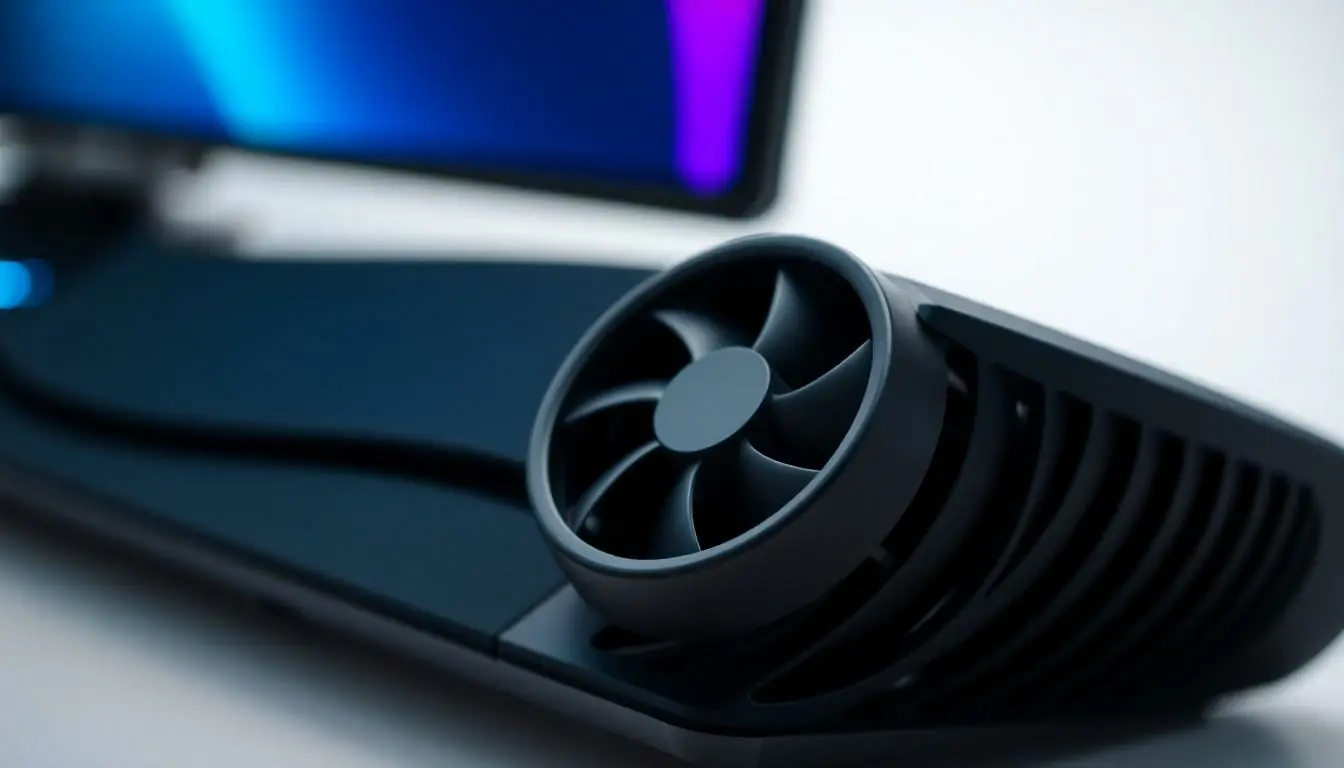Table of Contents
ToggleWhen it comes to gaming on the go, Valve’s Steam Deck takes the crown, but there’s one unsung hero that keeps the fun alive: the steam deck fan. Imagine diving into an epic battle only to be interrupted by a sudden heatwave—yikes! This little fan works tirelessly to ensure the device stays cool while you conquer virtual worlds, making it a true MVP in the gaming arena.
Overview of Steam Deck Fan
The Steam Deck fan is essential for cooling the device during gaming sessions. This cooling component prevents overheating, which can lead to performance throttling. Gamers rely on the fan to maintain optimal temperatures, ensuring smooth gameplay even during intense sessions.
Ventilation design plays a vital role in the fan’s functionality. Steam Deck incorporates strategically placed vents to facilitate airflow, allowing hot air to escape efficiently. A well-implemented cooling system not only enhances performance but also prolongs the lifespan of the device.
Fan speed adjusts dynamically based on internal temperatures. Higher demands often trigger increased fan activity, ensuring the system stays cool under pressure. Conversely, during lighter usage, the fan operates quietly, promoting a seamless gaming experience without unnecessary noise.
Cleaning the Steam Deck fan is important for maintaining peak performance. Dust accumulation can hinder airflow, leading to increased temperatures and potential performance degradation. Regular maintenance helps keep the fan running smoothly and efficiently.
User feedback highlights the effectiveness of the Steam Deck fan. Gamers report minimal overheating issues, even during extended play. Positive experiences reinforce the fan’s role as an unsung hero in providing a reliable gaming environment.
The Steam Deck fan significantly impacts overall gaming performance. Its design, functionality, and maintenance contribute to a consistent and enjoyable experience for gamers. Prioritizing proper cooling keeps the device functioning optimally during demanding tasks.
Design and Build Quality
The design and build quality of the Steam Deck fan contribute significantly to the device’s functionality and aesthetics.
Materials Used
High-quality materials enhance the fan’s effectiveness and durability. The fan typically incorporates durable plastics and metals, ensuring resilience against wear caused by frequent use. These materials support efficient heat dissipation, allowing the fan to maintain optimal performance under load. Thermally conductive components further improve heat transfer, keeping temperatures in check. Additionally, the use of robust bearings minimizes friction and operational noise, contributing to a quieter gaming experience. Overall, the combination of these materials helps sustain performance during prolonged gaming sessions.
Aesthetic Appeal
A sleek design complements the overall look of the Steam Deck. The fan integrates seamlessly into the device, with vents positioned to maintain a low profile while facilitating airflow. Its design aligns with the gaming aesthetic, appealing to enthusiasts. Subtle curves and a matte finish enhance the visual appeal without drawing attention away from the display. Lighting effects around the fan area can also be present, adding a modern touch. This emphasis on aesthetics makes the Steam Deck not only functional but visually striking, enhancing the overall user experience.
Performance Analysis
The Steam Deck fan significantly contributes to efficient cooling and overall gaming performance. Maintaining optimal temperatures ensures uninterrupted gameplay during intense sessions.
Cooling Efficiency
Cooling efficiency plays a vital role in the Steam Deck’s performance. The fan effectively regulates internal temperatures by adjusting its speed according to workload demands. During high-performance scenarios, the fan increases airflow to dissipate heat quickly, reducing the risk of thermal throttling. This dynamic response helps maintain frame rates and prevents lag. Unique ventilation designs incorporate strategically placed vents to enhance airflow, prolonging the device’s lifespan. Regular cleaning ensures these vents remain unobstructed, maximizing cooling performance.
Noise Levels
Noise levels also impact the gaming experience on the Steam Deck. Gamers appreciate that the fan operates quietly, especially during less demanding tasks. Quiet operation allows for immersive gameplay without disruptive noise. When under heavy load, the fan may generate more sound; however, it remains relatively low compared to competitors. Robust engineering minimizes vibration, further reducing audible noise. Feedback from users consistently highlights this balance between performance and noise, enhancing overall satisfaction during long gaming sessions.
User Experience
The Steam Deck fan significantly enhances user experience during gameplay. It ensures optimal cooling, preventing performance drops and enhancing device longevity.
Installation Process
Installing the Steam Deck fan is straightforward. Users simply need to remove the back panel for access. Once inside, detaching the old fan and connecting the new one is all it takes. No special tools are required, simplifying the swap for most users. Guides and video tutorials streamline the process, further supporting users in their efforts.
User Reviews and Feedback
User feedback highlights the fan’s effectiveness in cooling. Many gamers notice minimal overheating, even during marathon sessions. Complaints about excessive noise are rare; most appreciate the quiet operation, which enhances immersion. Positive reviews often mention the fan’s ability to adapt to usage demands, reflecting good engineering. Users commend the durable construction, often noting improved performance throughout their gaming experience.
Maintenance and Troubleshooting
Regular maintenance ensures the Steam Deck fan operates efficiently. Users benefit from maintaining optimal airflow by cleaning the vents frequently. Dust accumulation leads to airflow obstruction and increases overheating risks.
Inadequate cooling may result in performance throttling or unexpected shutdowns. Gamers should monitor the fan’s operation, especially during intense gaming sessions. A malfunctioning fan typically presents loud noises or irregular speeds. Addressing these signs early helps prevent hardware damage.
Replacing the fan remains straightforward when necessary. First, remove the back panel with the appropriate tools. Next, disconnect the fan connector and remove any screws holding it in place. After that, install the new fan and secure it carefully.
Documentation and video tutorials provide useful guidance throughout this process. Resources for troubleshooting include community forums and official support pages. Many users share their experiences, fostering a supportive environment for addressing common issues.
Maintaining the Steam Deck fan enhances overall device longevity. Regular cleaning minimizes overheating incidents and sustains peak performance. Staying proactive in troubleshooting ensures an uninterrupted gaming experience. Employing these strategies can significantly improve user satisfaction with the Steam Deck’s performance.
Conclusion
The Steam Deck fan is integral to the device’s performance and longevity. By ensuring optimal cooling during intensive gaming sessions it prevents overheating and enhances the overall user experience. Gamers can enjoy extended play without worrying about thermal throttling thanks to its efficient design and dynamic speed adjustments.
Regular maintenance and cleaning are key to keeping the fan in top shape. Users who prioritize upkeep will likely experience fewer issues and enjoy a more immersive gaming experience. With its durable construction and quiet operation the Steam Deck fan stands as a testament to Valve’s commitment to quality and performance, making it a vital component for any serious gamer.





